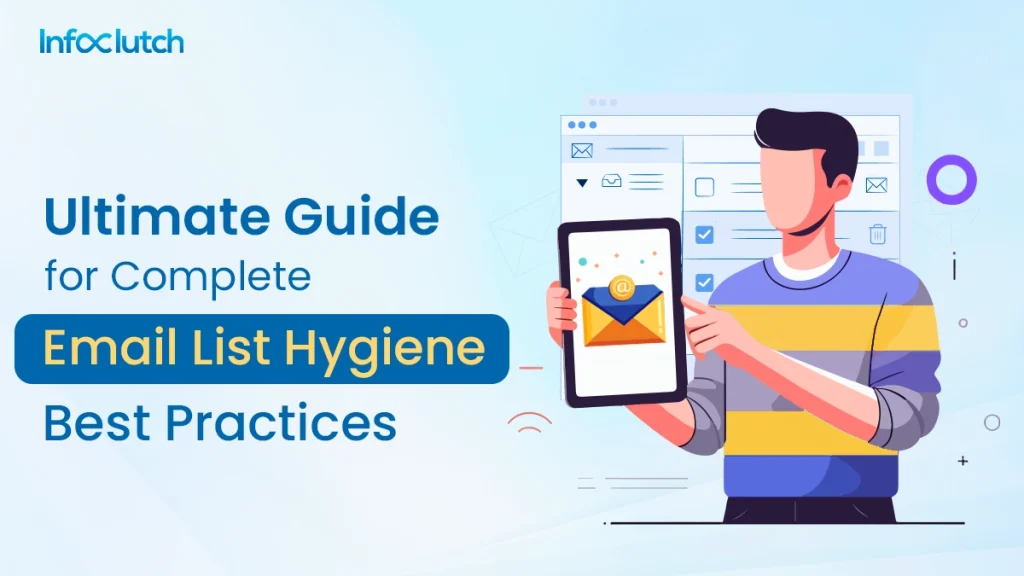Have you ever gotten irritated and annoyed when you see your inbox crammed to the brim with useless and unwanted emails that you have no intention of opening? If your answer is yes, then you are about to join the endless list of frustrated people who, like you, have been trying unsuccessfully to clean up their email folders and inboxes, but to no avail.
Emails are an essential part of our lives, from personal communication to professional correspondence. But what if we told you that there are best practices that can swiftly remove all the unwanted clutter from your inbox? These practices are not just effective; they’re also confidence-boosting.
To get better engagement and build a continuous rapport with your customers, businesses today, need to clean up their email list for better ROI. Reports state that there are well over 4.3 billion email users in the world today and by the end of 2026, it is projected to reach more than 4.7 billion.
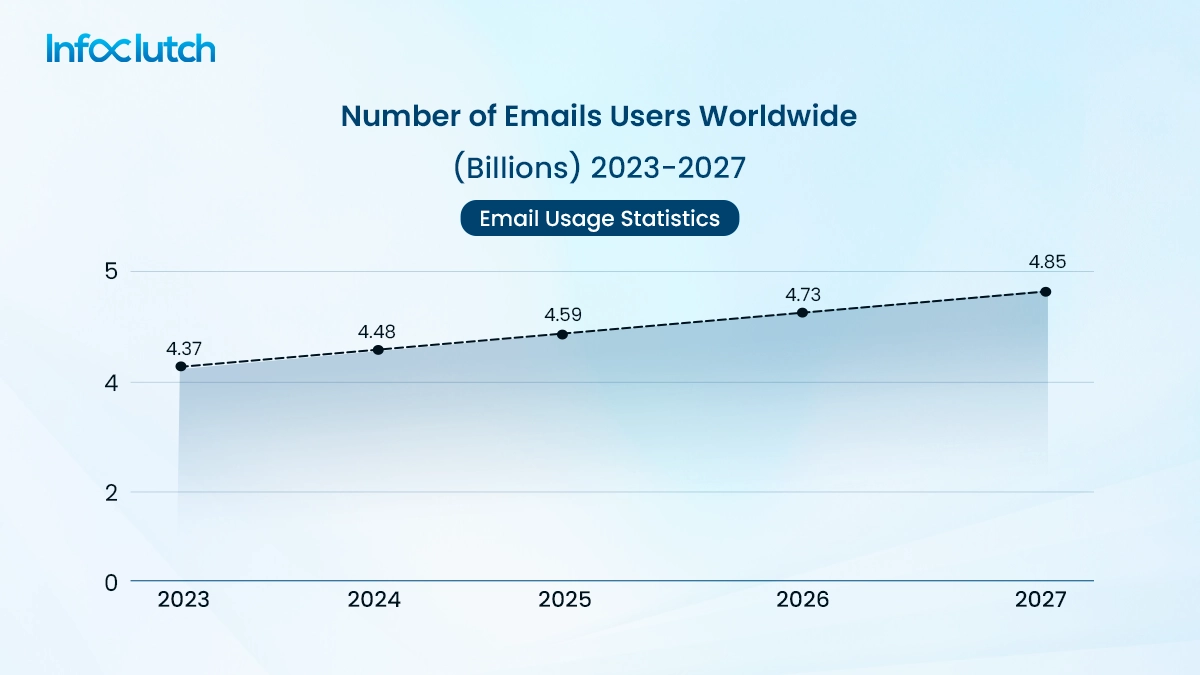
This blog is your guide to understanding and implementing healthy email list hygiene best practices. To ensure that your list hygiene is perfect and to get a thorough cleansing of your email list, you can click here. By learning about these methods, you’ll be in control of your subscriber base and your email marketing strategy.
What is Email List Hygiene?
Email list hygiene refers to the methods that you use to keep your inbox free from invalid, spam, and unwanted mail. It is the process that helps you eradicate unengaged subscribers by removing them permanently from your mailing list, thereby ensuring that you possess only a high-quality, legitimate mailing list to promote your business offerings.
For businesses, having a good email list hygiene is of great significance as it helps to identify valid customers who truly wish to receive emails from us. It helps you to avoid spam and also build a more meaningful relationship with your customers.
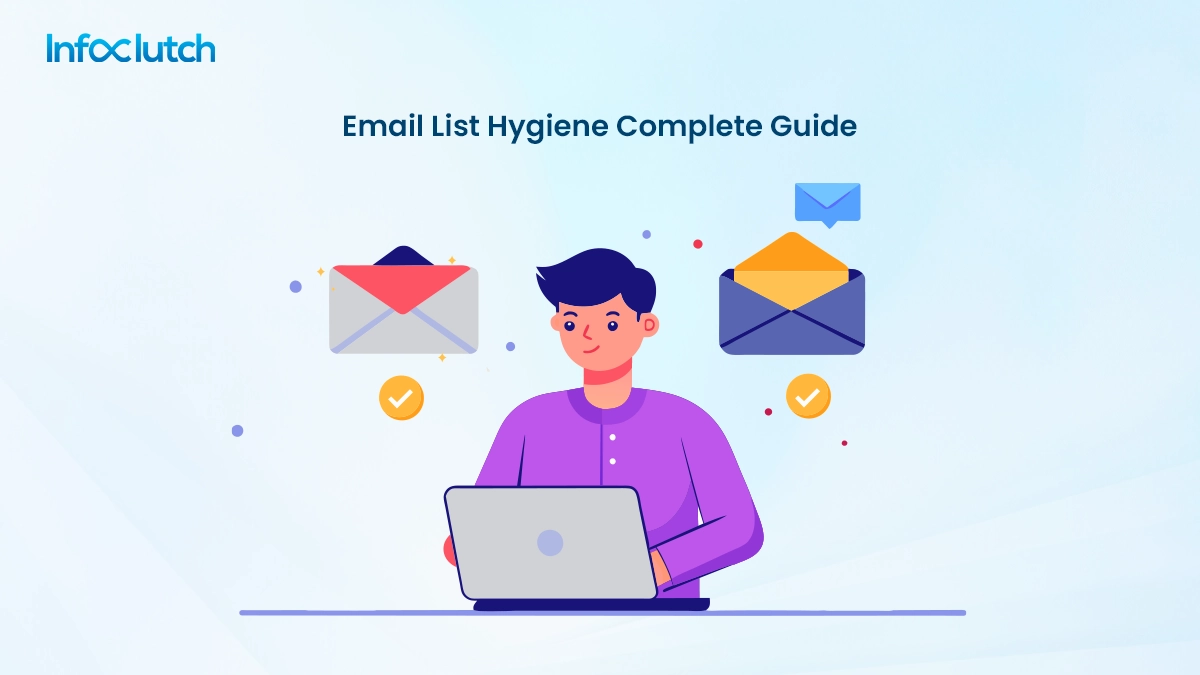
Importance of Maintaining a Clean Email List
For businesses, email list hygiene is of critical importance. Every email sent to your subscribers counts – be it newsletters, offer updates, referral programs, or mere announcements. It helps increase your customer base, as it not only popularizes your offerings and improves your deliverability rates but also boosts engagement and drives better conversions.
Given below are a few pointers that help you understand the importance of maintaining a clean email list:
Improved Deliverability
One of the main reasons for maintaining a clean email list is that it helps improve deliverability rates for your business. With your extensive subscriber list, you send emails to all of them, thinking that every single customer is going to read your catchy headlines and tags and click on your website for conversions. But what you get is just the opposite!
Your business can thrive only if you have a loyal customer base, and to garner their attention, you need to check all the boxes in sending them important snippets about your company, offers exclusively tailor-made for them, and literally shower them with a lot of attention. The prospect of losing your customers will definitely take a huge toll on your business.
If most of your emails get sent to a large group of inactive customers, it can negatively impact your sender’s reputation. As a result, you will get caught in a web of spam, flagged by your Email Service Providers (ESP), if your emails are being sent continuously to unwanted or invalid emails.
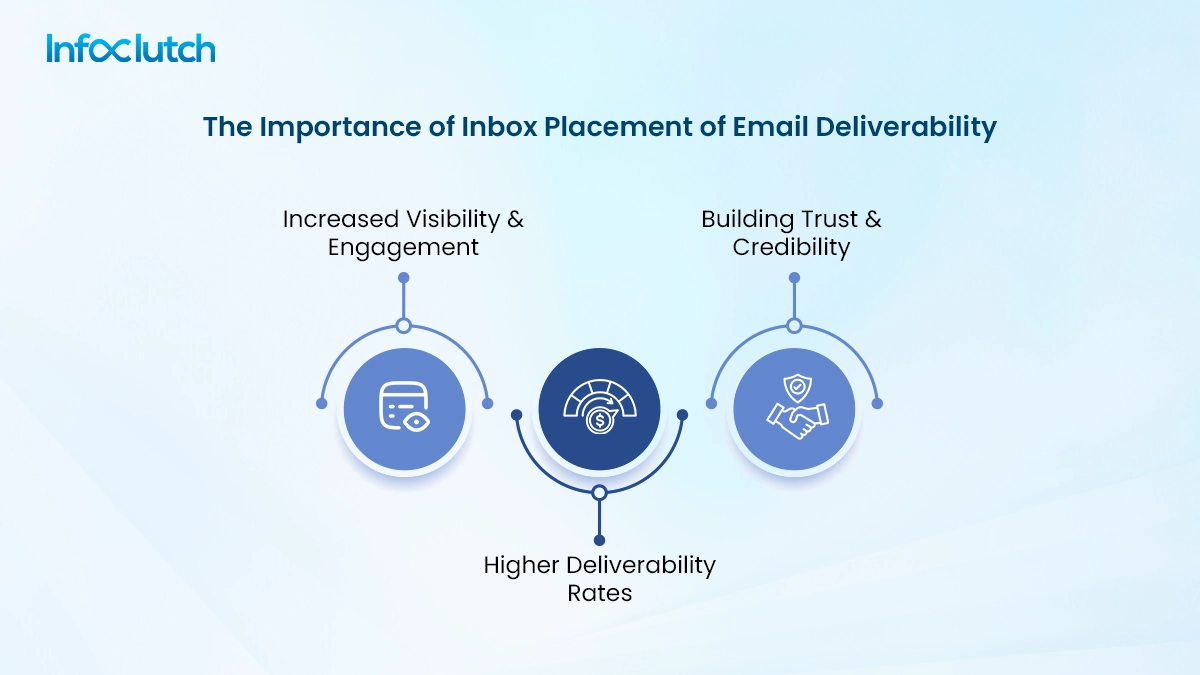
Reduce your Bounce Rates
When you craft an email, your key focus is to ensure that it gets landed in the recipient’s inbox successfully. This is called Email Deliverability. If your emails reach your recipient’s main inbox, then they are successful. Otherwise, everything will bounce and end up in your subscriber’s spam folder and be blocked completely from their view.
There are two types of bounce rates, namely:
a) The soft bounce rate
Soft bounces are short-term email delivery failures that occur if your recipient’s inbox is full, there is a technical snag, or the content of the mail is too large to fit into a single email. These can be resolved quickly without any further issues.
b) The hard bounce rate
Hard bounces, on the other hand, refer to permanently blocked emails, invalid email addresses, and non-existent domain names. These are permanent email delivery failures and have to be removed from your email list to maintain healthy email list hygiene.
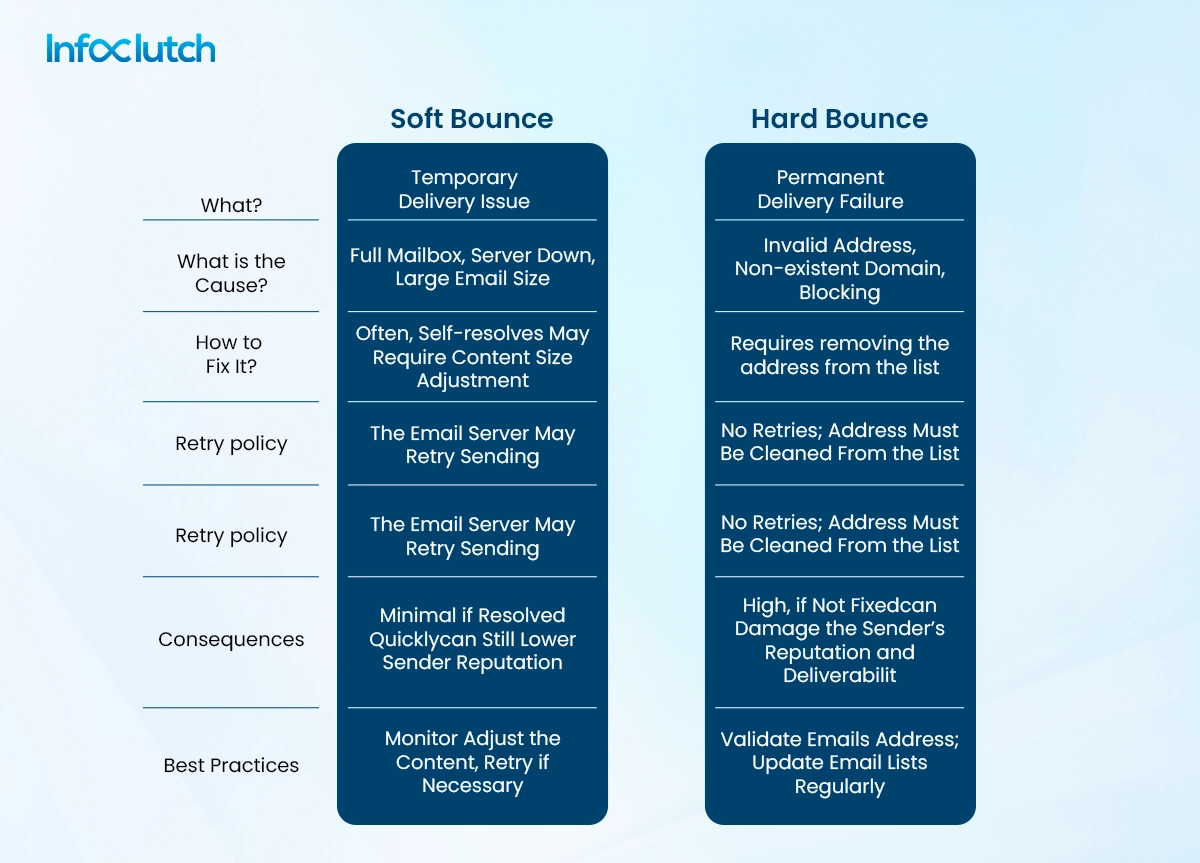
Higher Engagement Metrics
Having a healthy email list can give you higher metrics in terms of engagement, such as open and click-through rates. When you cut down all the non-existent or inactive subscribers and focus more on those who are genuinely interested in what you have to offer, you can gradually see a marked improvement in your engagement rates.
This process further allows you to analyze prevalent trends in content engagement and your customers’ peak levels of interest when they open your emails and read them.
Given below are the metrics that you should be aware of:
a) Increased Open Rates
This ensures that highly active subscribers are going to open your emails.
b) Higher Click-through Rates
These rates ensure that subscribers who are already engaged with your brand will definitely interact with your content.
c) Lower Unsubscribe Rates
They help you remove unwanted users from your mailing list, thereby reducing the likelihood of people manually subscribing.
These metrics not only monitor your email list but also help you create a mailing strategy to approach your customers easily.
Increased ROI on Email Marketing Efforts
Having good email list hygiene can help you procure a higher return on investment (ROI) for all the efforts that you have put into email marketing by:
a) Cost Efficiency:
It helps reduce costs by removing inactive subscribers from your list.
b) Improved Targeting:
A clean list allows for more accurate segmentation and personalization, leading to more effective subscribers
c) Higher Conversion Rates:
Customers who are engaged are likely to accept your offerings, eventually leading to high conversions.
Focusing on an audience that solely consists of interested people helps maximize your ROI if you have any email marketing campaigns up and about.
How to Identify Which Lists Need Cleaning?
Unsure of the lists that need a thorough scrubbing? Let’s get started on how you can segregate your mailing lists:
a) Spam:
Any mail that you have not subscribed to or any mail that you find automated and fake ends up as spam. High complaint rates and a surge in subscribed complaint email addresses usually distinguish these emails. For someone who uses emails regularly for personal as well as professional correspondence, you can easily identify which emails are genuine and which are fake.
For example, emails ending with info@, admin@, etc., are to be monitored with extreme caution as they can be high indicators of spam. Apart from this, if your inbox experiences a high influx of emails with unknown addresses, then it’s a sure sign of spam bots.
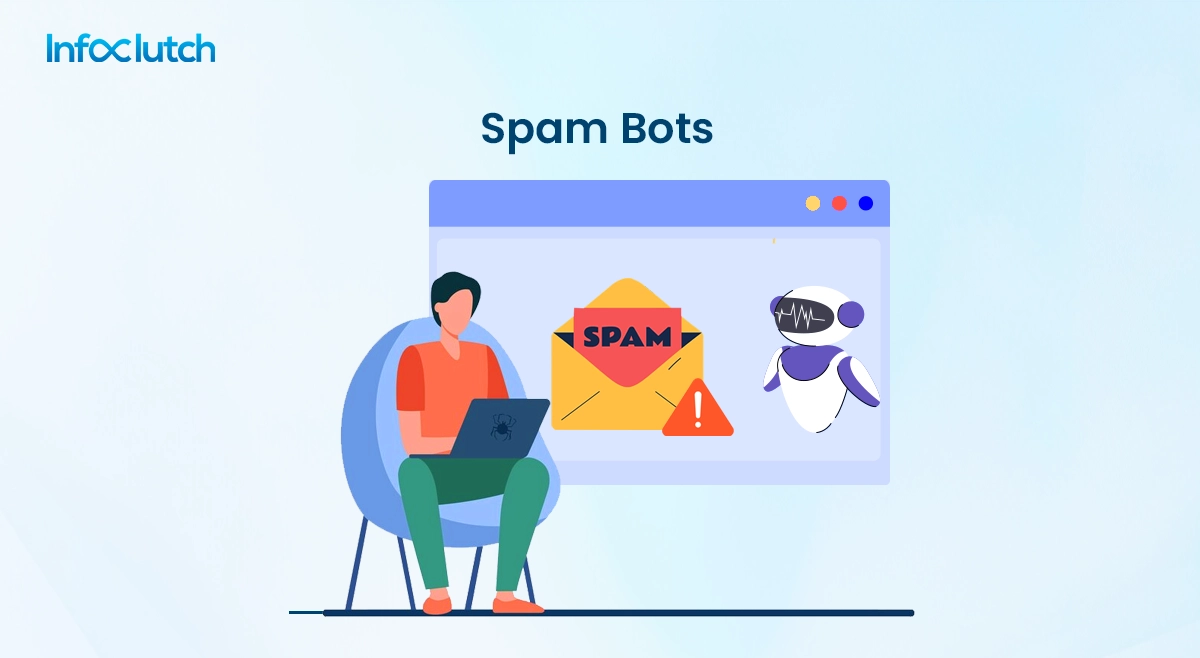
b) Lists with low engagement rates:
As a business owner, if your emails are returning unopened, have low click-through rates, or have a lack of interest in opening and reading emails from your subscribers, you can be assured that you have a low engagement factor. An extended period of low engagement means that your list needs a thorough cleansing.
To identify low engagement rates, you must first set a clear benchmark comprising of open acceptance and click-through rates and segregate your subscribers to their last date of interacting with you (your mails). You can also analyze the trends of declining interest in customers by spotting a consistent drop in these trends/metrics. If you find any anomalies, then it is high time you cleaned your list.
c) Old Lists:
Is there a way to identify old lists? Yes, there is! Old lists mostly consist of outdated or expired information about someone or something that you have been sending/receiving emails from. An easy method of characterizing old lists is to segment the subscribers from whom you haven’t engaged, say from 6-12 months. Sending emails to these subscribers is unnecessary and a waste of time and money.
Another method is, if you have been continually receiving hard bounces for over a year, this can indicate that your list has aged and is in need of a nice cleaning. In other cases, your subscribers may have moved on, changed their email addresses, or may have lost interest in your offerings. If your content seems irrelevant to a significant portion of your list, it may be because the list has become outdated.
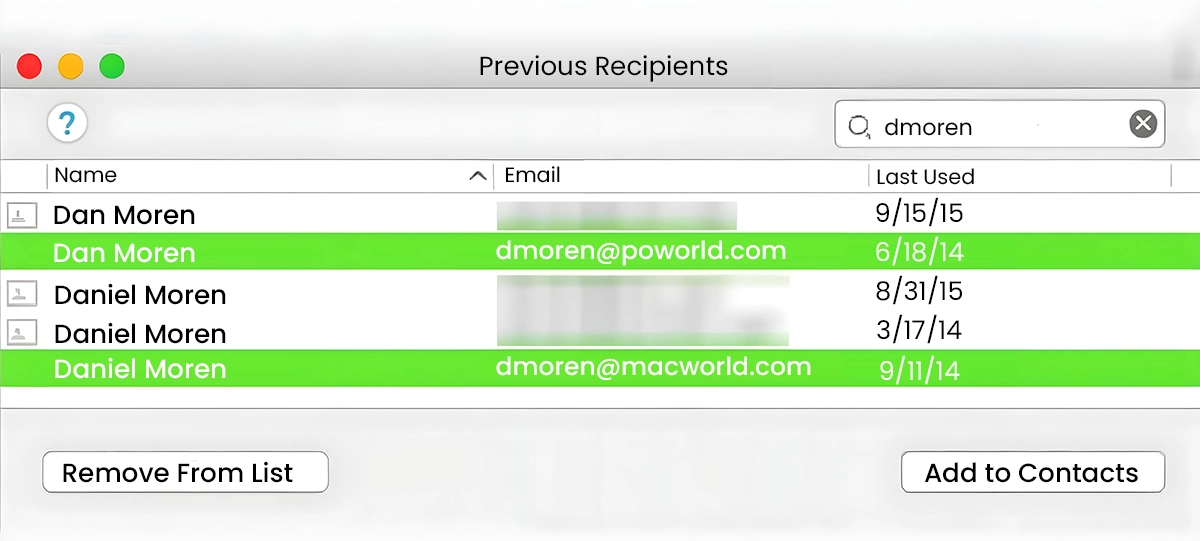
d) Lists with high bounce rates
For a business that has a high bounce rate, it is in the problematic zone. Ensure that your bounce rates are rigorously kept under 2%. You can check for patterns in your bounce emails by differentiating the domain names or email addresses that regularly come under the bounce list.
As there are soft bounces (full inboxes, network connectivity) as well, you must pay complete attention to the bounced emails. Hard bounces contain emails that have permanent delivery failures caused by invalid email addresses. If there is a sudden increase in the bounce rate, then it is apparent that your email list needs cleaning.
e) Lists that are underperforming:
No matter the content you send, your emails are always underperforming – low conversion rates, poor ROI, and a steady decrease in engagement ratio. It means that your email lists are not performing up to your intended target,
If you want to evaluate your underperforming email lists, you will have to compare their performance with industry benchmarks and other available data. You will have to analyze every list thoroughly for low or poor performance across the campaigns that you have set. If the results are not satisfactory, then it’s time for you to check your email list hygiene.
f) When your forms are not protected:
Unprotected forms in emails are the most vulnerable, as they experience quality issues. Regularly check if there are any unprecedented spikes in the forms after submission. You may also have to check the email addresses of subscribers that are fake or automated.
Thoroughly check the quality of the forms that have been submitted. If, at all, you analyze an increase in suspicious email addresses that are spam, it can lead to your forms not being protected, and your list needs a good cleaning.
g) When you rebrand your business:
When you rebrand your business, be prepared to lose a few subscribers as well. For a brand that has been continually operating under the same name/logo, your subscribers would have gotten used to your offerings and branding.
If you rebrand your email list, your subscribers might not recognize your brand or find it suitable to their interests. Before you proceed to rebrand your email list/offerings/brand, get feedback from your existing subscribers to gauge their reaction if you opt for rebranding.
How Often Should You Clean Your Email Lists?
Email list cleaning is an important practice that has to be performed to maintain a healthy subscriber list. Every business owner’s list will have different issues, and the cleaning time may vary for each owner. However, the general thumb rule is that email lists can be cleaned every six months or even once a year.
Here is a breakdown of the possible factors on how often you should clean your email list:
a) Quarterly (every 3 months)
Cleaning your list every three months is a good practice as it helps you weed out customers who are not interested in your offerings. It also helps to clear up spam. This quarterly cleaning can be followed by businesses whose lists are extensive and send more frequent emails.
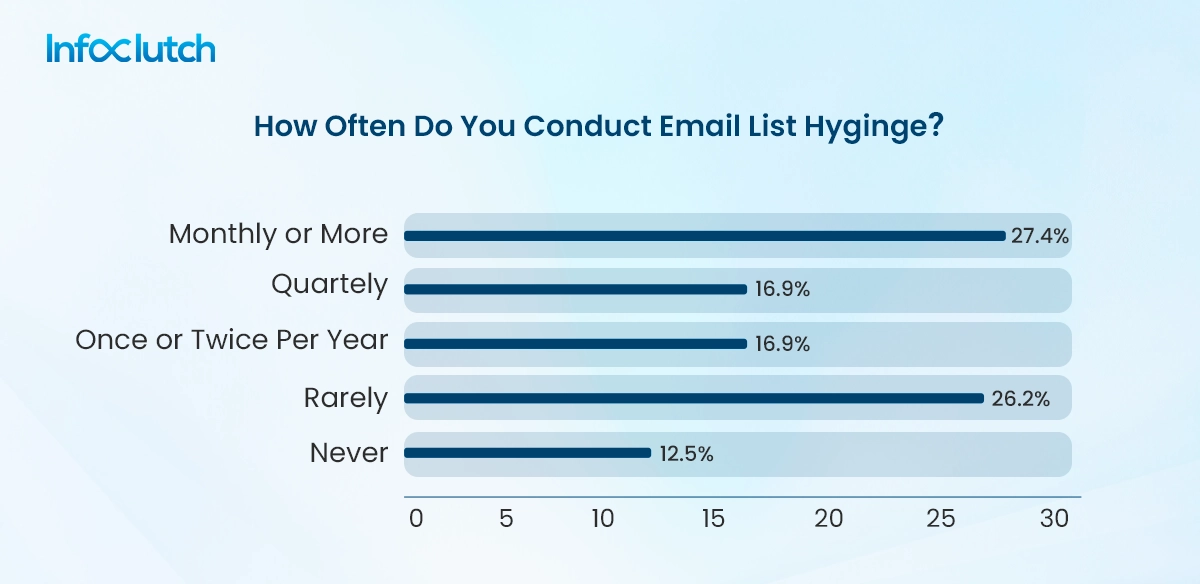
b) Half-yearly (every six months)
For businesses having a tough time segregating their emails based on inactive subscribers and maintaining excellent deliverability rates, the half-yearly email list cleaning would be the apt choice.
c) Annually (Yearly)
To maintain organic email hygiene, it is advisable to scrub your lists annually. Even if your list is small or you have infrequent emailing, to ensure that you have good deliverability rates, an annual list cleaning works best.
Factors Influencing the Cleaning Frequency
A good cleaning list frequency is based on several factors. They are:
a) List Size
If you have a list size of more than 10k+ subscribers, then you can perform frequent list cleaning – say every month. Businesses with a smaller list size can choose a less rigorous scrubbing.
b) List Growth Rate
For businesses that have a growing list of subscribers, then cleansing has to be done often as it can give rise to plenty of invalid emails.
c) Sending frequency
If you are a business owner, who relies entirely on sending emails daily, then you can clean your email list as often as required.
d) Industry and Audience
There are specific industries or customer lists that may need a higher rate of email turnover, thereby necessitating the need for weekly list cleaning.
e) Ongoing maintenance
While regular deep cleaning of email lists is important, maintaining good email hygiene is an ongoing process. Spams, hard bounces, and invalid subscribers should be removed regularly.
Email List Hygiene: Best Practices to Follow
Implement double opt-in
Double opt-in is a crucial practice for maintaining a high-quality email list. This two-step process requires subscribers to confirm their subscription after initially signing up, ensuring that only genuinely interested individuals are added to your list.
Given below are some of the benefits of double opt-in:
Improved List Frequency
Double opt-in greatly reduces the chances of invalid or fake email addresses being added to your list. As it is a two-pronged process, double confirmation is required to ensure that the email address entered is valid and belongs to the subscriber who signed up.
Higher Engagement Rates
You can receive higher click-through rates and conversion rates from subscribers who are genuinely interested in your content and offerings.
Protection against Spam
While General Data Protection Regulation (GPDR) is not mandatory, double opt-in requires demonstrating consent and maintaining data service.
Remove inactive subscribers
To effectively manage inactive subscribers, first define what inactivity means for your audience.
Time-frame
Consider the period- typically, 3-6 months of no engagement is a good starting point, though it may vary based on your industry.
Engagement Metrics
Next, identify engagement metrics that signify inactivity. Common indicators include a lack of email opens, clicks, website visits, or purchases.
Email Frequency
If you send emails often, a shorter inactivity window may be appropriate. This is called Email Frequency.
Steps to identify and remove inactive subscribers
Follow these steps to effectively manage inactive subscribers and maintain a high-quality email list:
- Start by segmenting your list using your email marketing platform. This allows you to isolate subscribers who meet your inactivity criteria.
- Next, analyze the segment for patterns or insights that could inform your re-engagement strategy.
- Plan a re-engagement campaign to reach out before removal. This gives inactive subscribers a chance to reconnect.
- After the campaign, proceed to remove non-responders. Unsubscribe them or move them to a suppression list based on your policies.
- Lastly, ensure you document the process for compliance and future reference.
Manage Bounce Rates
Managing bounce rates is crucial for maintaining a healthy email marketing campaign and optimizing website performance. There are two main types of bounces: hard bounces and soft bounces-
Hard bounces occur when an email is permanently undeliverable due to invalid or non-existent email addresses. Remove them immediately to maintain and protect your sender’s reputation.
Soft bounces are temporary delivery failures, often caused by full inboxes or server issues. If soft bounces recur often, then they should be converted into hard bounces.
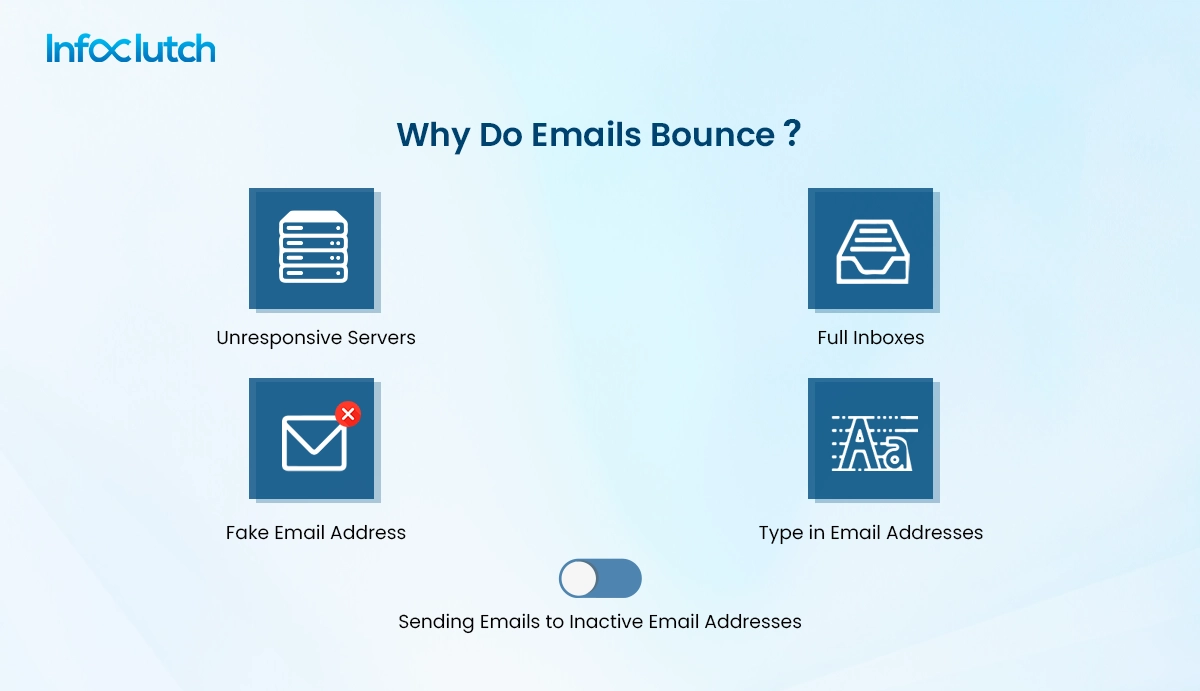
Regularly cleaning your email list will ensure timely removal of these type of bounces, protect your sender reputation and proper redressal of your mails getting reached to your subscribers list.
If you are worried about your website bounce rates, try to focus more on areas such as page load times, content readability, and mobile responsiveness. Analyzing these key areas will help identify patterns and rectify those to maintain a healthy email list so that you can improve your overall marketing effectiveness.
Use Email Verification Tools
If you are after better deliverability rates, then you will have to employ email verification tools. Using email verification tools is important for maintaining honest and clean email communications.
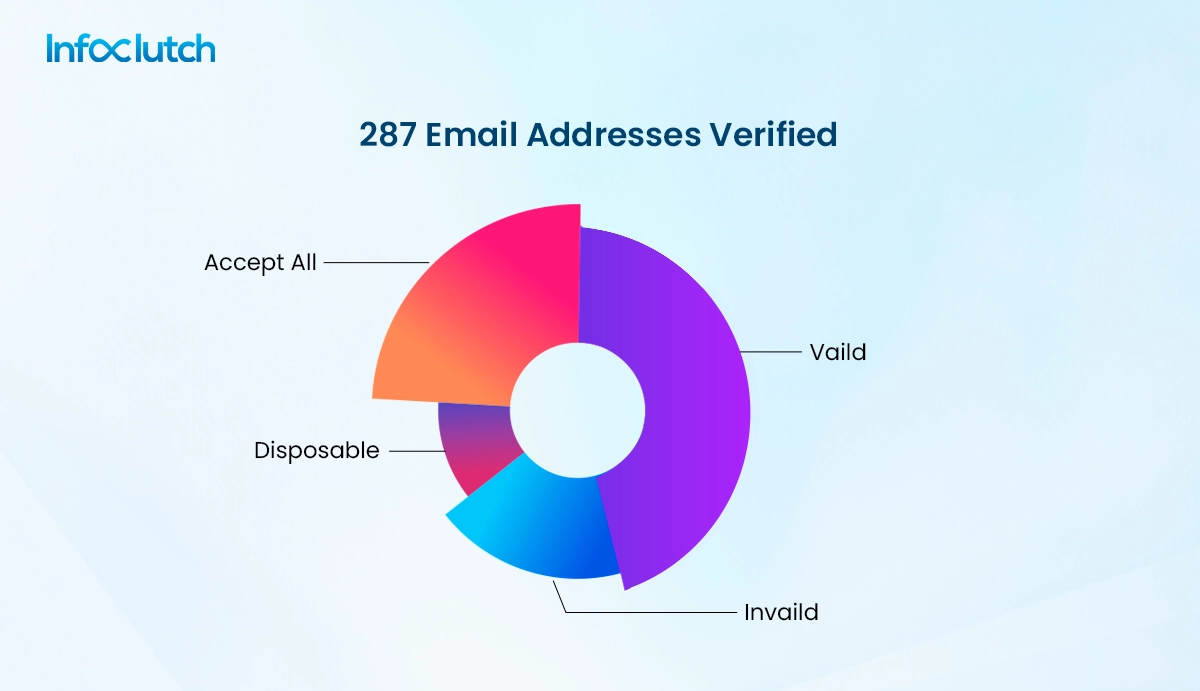
Given below are a few benefits of email verification:
Improved Deliverability
By regulating the practice of email verification, you can significantly bring down bounce rates, which can improve your sender’s reputation with email service providers (ESP). Keeping your list clean means that your emails are being delivered to real users rather than pushed to spam.
Enhanced Engagement
Emails that are validated can lead to higher open and click-through rates. This means your emails are being read by actual users, who can greatly increase your engagement rates, thus creating a positive impact on your campaigns.
Cost Efficiency
Think of all those unnecessary costs that you would incur if you send emails to unwanted and invalid recipients! You can cut down costs if you use email verification tools. These tools help you identify the email addresses of genuine subscribers, and you can send mail to them based on your campaigns.
How to Integrate Email Verification into your Process?
You can implement a real-time email verification API into your process, thereby allowing it to scan your emails and check if they are valid. This dynamic approach prevents invalid emails from entering your database by ensuring quality at the beginning of the chain.
The API implementation can be viewed with the help of the below chart:
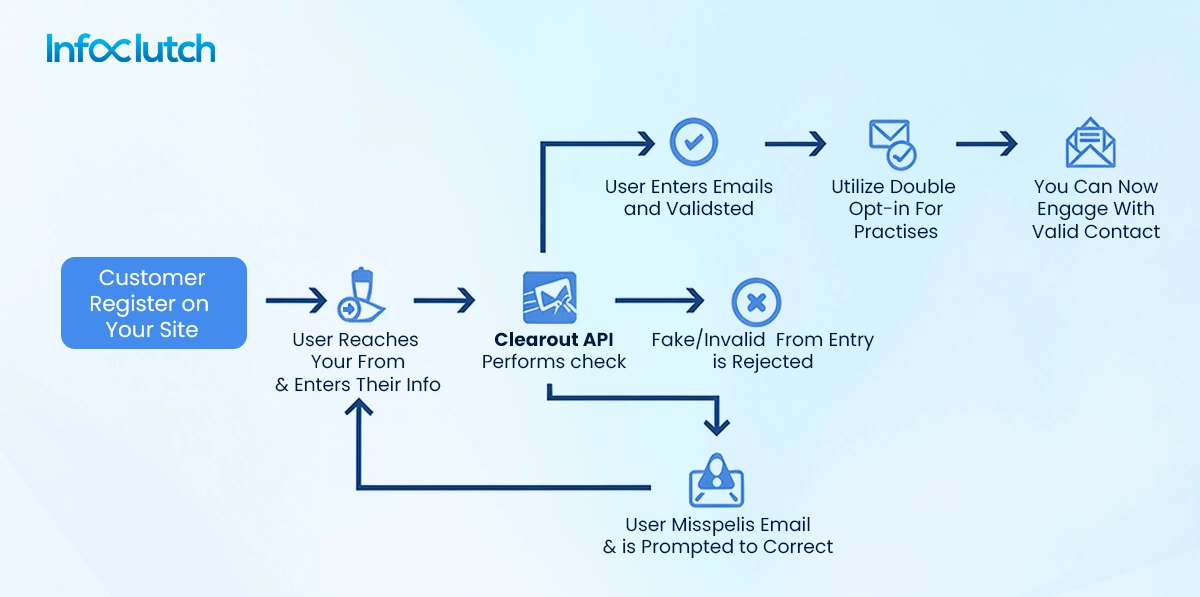
Segment your email list
Most email lists will have subscribers belonging to different categories. You may have to segregate them according to the campaigns that you run. Therefore, always ensure that you segment your email list after you clean it.
You can segment your subscribers based on the following:
- Demographics
- Purchase History
- Groups are responding positively to all campaigns, including those who don’t.
These segregations will make it easier for you to increase customer engagement and increase the chance of click-through rates.
Criteria for Email Segmentation
Most businesses fail as they are under the impression that all email subscribers require the same content, irrespective of their demographics. Suppose you are sending out newsletters or images containing only general information about your company. In that case, you cannot expect engagement to increase or your customers to be interested in opening your emails and reading.
That’s why we urge you to employ proper email verification APIs. Remember, the goal of segmentation is to deliver the right message to the right people at the right time.
Here is a diagram to help you understand email segmentation better:
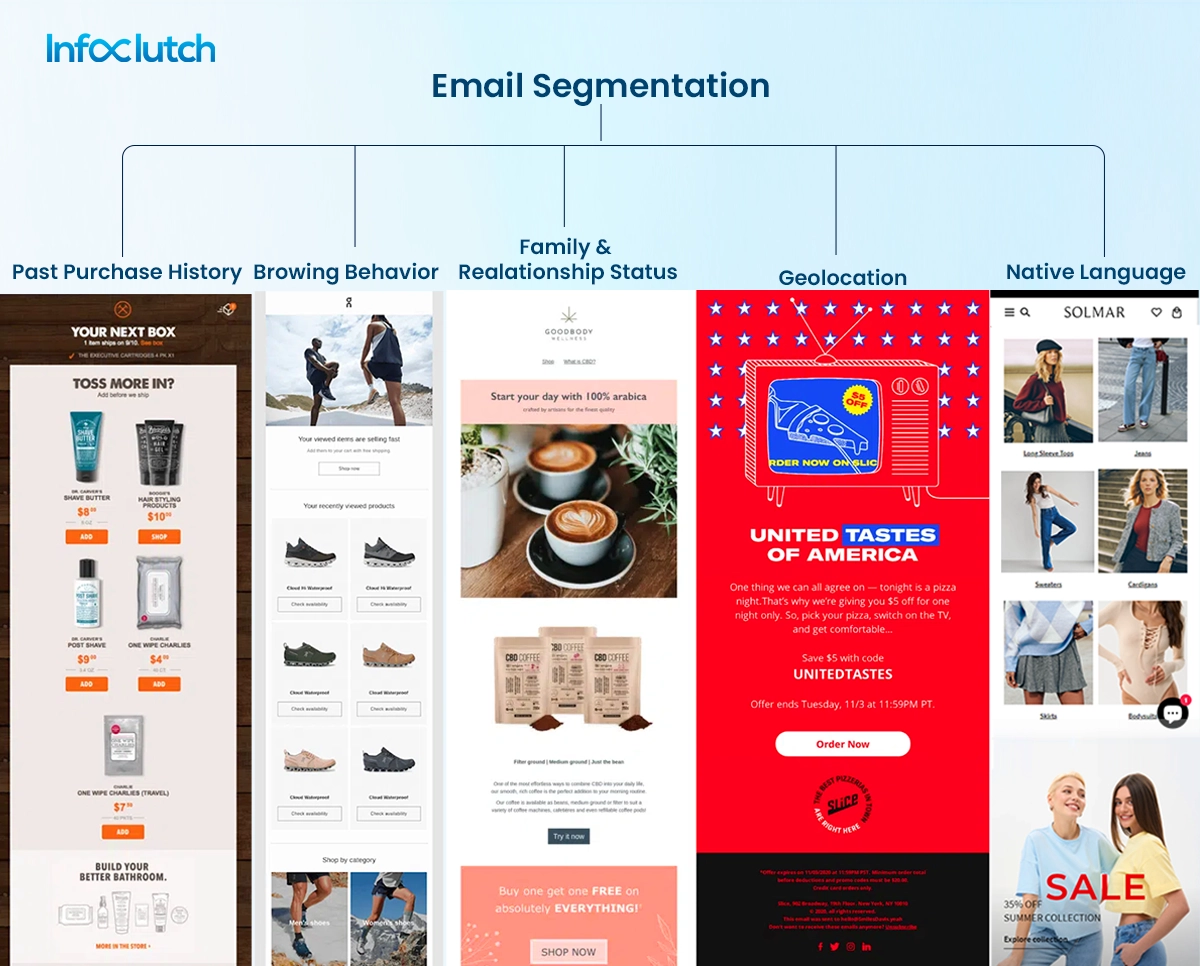
By leveraging these criteria effectively, you can create highly targeted email campaigns that resonate with your subscribers and drive better results for your business.
Provide Easy Email Unsubscribe Options.
As a business owner, you cannot impose your offerings on your subscribers. Provide them with an opt-down option whereby your subscribers can change their email preferences without having to unsubscribe from your list.
a) Legal Requirements for Unsubscribe Links
Most regions in the USA have made it legal for commercial businesses to provide their subscribers with an unsubscribe option.
USA’s CAN-SPAM (Controlling the Assault of Non-Solicited Pornography and Marketing) Act of 2003 requires an explanation from business owners of how recipients can opt out. The process is so simple that recipients who have chosen to opt-out will be unsubscribed within ten working days.
In the European Union, the GDPR (The General Data Protection Regulation) mandates that unsubscribe mechanisms be clear and easily accessible. Similarly, Canada’s CASL (Canada’s Anti-Spam Legislation) and Australia’s Spam Act require functional unsubscribe options, with requests processed within specific time frames.
b) Implementing Opt-Down Options
Generally, an opt-down option allows subscribers to reduce the frequency of the emails that they are receiving or the option to unsubscribe from the mailing list completely.
As a business owner, you can equip your subscribers with options that help them adjust their preferences in a single click rather than pushing them to another page. Additionally, consider collecting feedback on why users are unsubscribing, which can guide your opt-down choices.
Benefits of a Smooth Email Unsubscribe Process
Here are a few benefits of a smooth email unsubscribe process:
- It helps you avoid fines and other legal complications by mandating legal compliance. It also helps improve your sender reputation with top email service providers like Gmail and Yahoo.
- Providing options to unsubscribe, opt-in, and opt-out helps build trust with your subscribers. With all these straightforward options, your customers will not mark your emails as spam.
- It helps improve list quality by weeding out uninterested subscribers.
- You can also collect feedback from customers to refine your email marketing strategy.
- Prioritizing an easy unsubscribe process ultimately fosters better relationships with your audience.
Address Role-Based Email Accounts
Role-based accounts refer to email accounts that are associated with a specific function or group within a company. Role-based accounts do not belong to any people. Role-based accounts are often created to address queries/grievances pertaining to a particular job function. Examples of role-based email addresses include addresses like support@company.com, info@organization.net, sales@enterprise.org, etc.
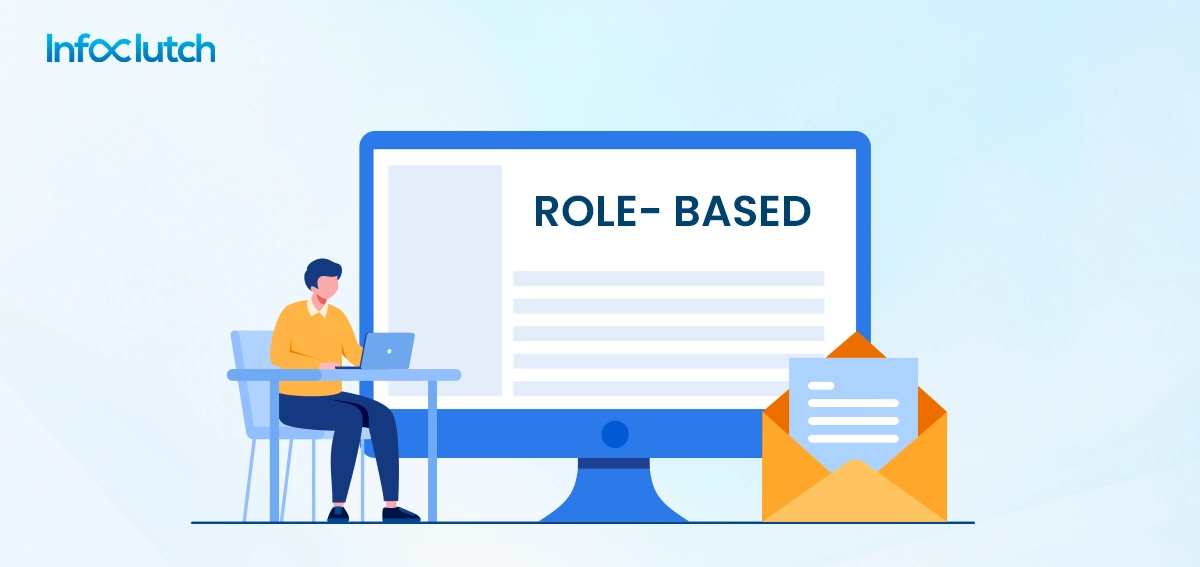
Importance of Role-based Accounts
- Role-based email accounts help recipients connect with the right person at the right time so that their queries/concerns get redressed immediately.
- These email accounts help you delegate tasks quickly. The emails being sent to the concerned department reduce the monotony.
- It increases your brand image when you use role-based emails. Customers looking for a resolution can get it addressed once they see that there is a dedicated team that effortlessly manages all the grievances/complaints/queries/suggestions of subscribers.
- This helps build long-standing relationships, thereby inducing customers to trust your brand and offerings.
How to activate role based email account checking?
Most businesses use a separate business email hosting service as their domain for handling all business-related emails and also create a few alias accounts as well from the same domain. For instance, your company has the following departments, and rather than addressing one single person, you can address the entire team. Some common role-based emails within a company are:
- Accounting team: accounting@; finance@;
- Sales team: sales@;
- Marketing team: marketing@;
- Legal team: legal@
- Housekeeping team: support staff@
- and more

It is up to you to decide which of the role-based teams you want to offer your subscribers. You can also decide the email addresses depending on the number of employees in each department by providing them with separate credentials (Username and Password).
Monitor your email metrics
As a business owner, you have been sending out emails for quite some time. But how will you assess if your email campaigns are performing well or not? To identify these, you would need engagement metrics. These metrics not only determine your campaign’s success but also help you refine your email campaign strategies effectively.
Why should you monitor email metrics?
Monitoring engagement metrics is crucial for understanding how effectively your email program is performing and resonating with your audience. Key metrics to track include open rate, click-through rate, conversion rate, and unsubscribe rate. Currently, email marketing has an average return on investment (ROI) of $38 for every $1 spent.
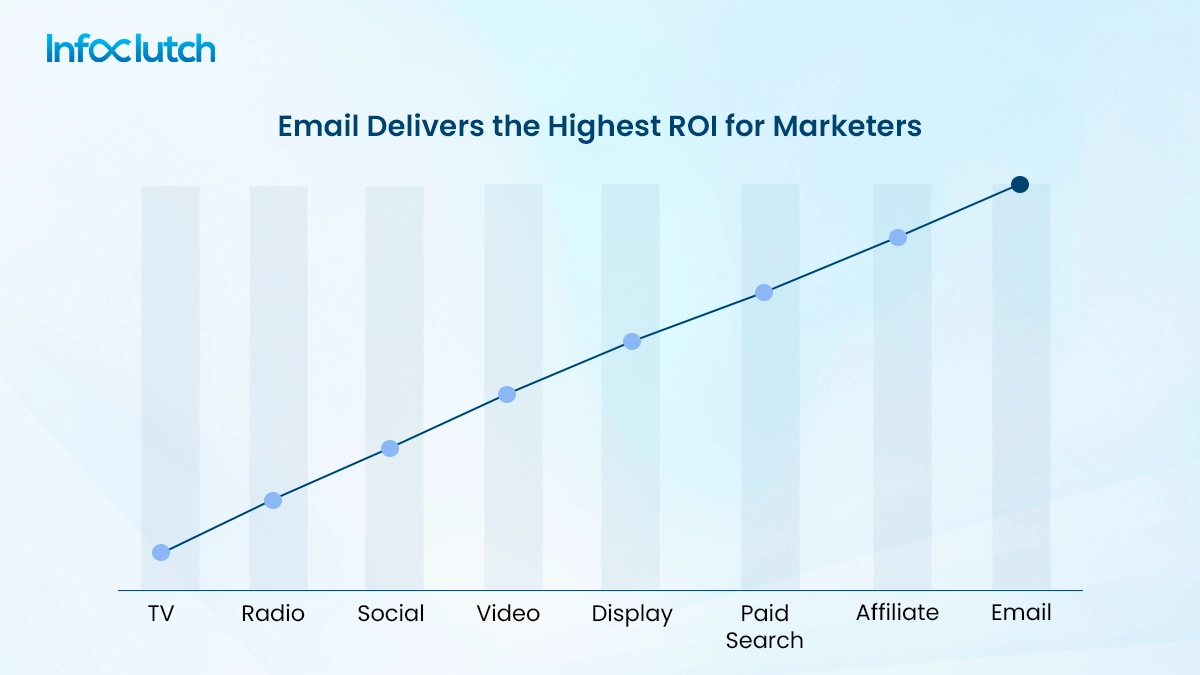
Setting Benchmarks for Your Email Program
You will have to set certain parameters to assess your benchmarks as they help you to identify your areas of improvement. Begin by establishing a baseline with which to compare your email campaigns. Set goals that are easily achievable as they help improve your performance gradually.
To set effective benchmarks, segment your email list and analyze performance across different subscriber groups. Monitor the benchmarks based on the type of audience, demographics, and purchase history. You can also track any spikes that have occurred while assessing the performance of the benchmarks set. By consistently monitoring your metrics against established benchmarks, you can quickly identify underperforming campaigns, test new strategies, and optimize your email program for maximum engagement and effectiveness.
Key Takeaways
We have reached the end of the blog. Let us do a brief recap of what we have covered so far.
Maintaining a clean email list is an essential aspect for any business to succeed. Optimizing your email list for deliverability using some of the best practices mentioned above is a key way to increase your click-through rates, engagement, and conversions.
Remember, the quality of your email list is more important than its size. A smaller, engaged list will yield better results than a large, unresponsive one. Regularly cleaning your email list helps improve deliverability, maintain a good sender reputation, and ensures that your emails reach an audience that genuinely wants to engage with your content.
Frequently Asked Questions
1. How do you keep a healthy email list hygiene?
Ans: Email lists can be kept clean if you regularly remove invalid email addresses and throw away the spam folders.
2. How do email bounce rates impact the sender’s reputation?
Ans: High bounce rates can adversely affect your reputation. Email service providers (ESPs) use bounce rates as a key metric to gauge the quality of your email lists and your adherence to best practices. Ensure that your bounce rates are rigorously kept under 2%.
3. Why should businesses use an email verification tool?
Ans: An email verifier, or email checker, is a tool to validate that an email address exists and can receive emails. When businesses have lengthy email lists, manual verification is costly and tedious. Hence, this tool helps check legitimate email addresses quickly.
4. What is email list segmentation?
Ans: Email segmentation helps you group your subscribers based on general criteria, such as age, gender, demographics, purchase history, etc., so that you can send customized emails based on their preferences.
5. What are role-based email addresses?
Ans: Role-based email addresses are created to handle your company’s inbound emails. With the help of role-based emails, you can help resolve your subscribers’ queries/concerns easily.
Conclusion
Email list hygiene is not just a best practice—it’s a necessity for any successful email marketing strategy. Regularly assessing these factors will help you identify which lists need cleaning, allowing you to maintain a healthy, engaged subscriber base.
Remember that list cleaning should be an ongoing process, ideally performed at least once a year, but more frequently for larger or rapidly growing lists. It ensures your messages reach the right people, enhances your reputation as a sender, and ultimately drives better results for your business.
